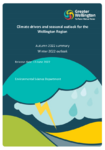Climate drivers and seasonal outlook for the Wellington Region - Autumn 2022 summary and Winter 2022 outlook
Search in document library
Autumn 2022 was second equal hottest on record for New Zealand, and the hottest on record for the eastern coast around Castlepoint. The season was once again marked by a predominant easterly La Niña flow, with balmy sub-tropical air making significant incursions mostly during north-easterly flows. Warm Sea Surface Temperatures (SST) helped moderate the climate, and Castlepoint had May temperatures that were closer to those expected in December. An atmospheric river event late in March brought over 100 mm of rainfall within 24 hours to the same Castlepoint area. In May, some exceptionally high humidity levels (dew point close to 20 degrees Celsius) created balmy conditions once again on the east coast, resembling closer to what would be expected for Brisbane at this time of the year. A series of unprecedented heat anomalies around the South Pole were also observed in March and May, highlighting how climate change is impacting the Southern Ocean. Ex-Tropical Cyclone Fili just missed the region in April, and so further flooding was mostly confined around Gisborne. A very active band of thunderstorms also crossed the region from north to south on the 22 March, with some spectacular displays both in the Wairarapa and Wellington. Rainfall was generally below average south of Masterton, as the region missed out on most of the rain events further north. April was the second driest on record for Masterton and Martinborough.
